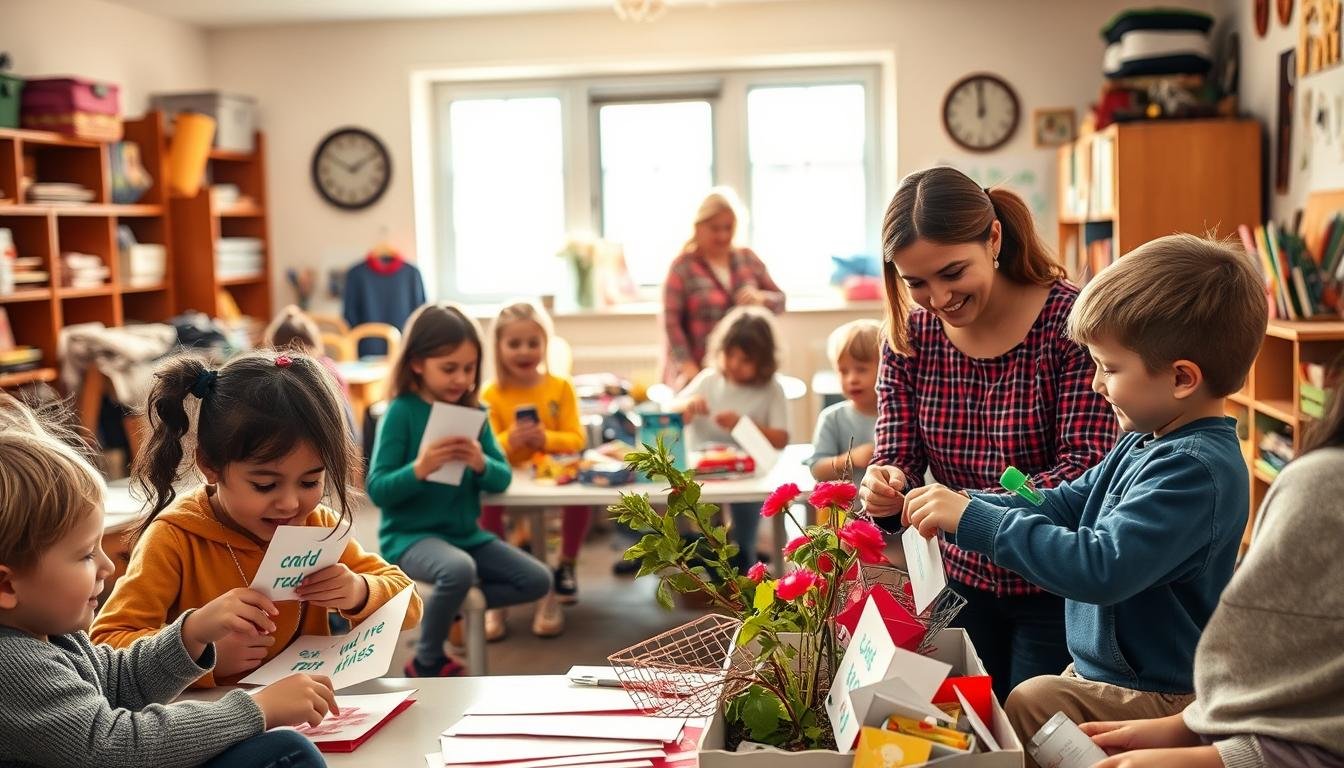What if the simplest gestures could shape a child’s future and create a kinder world? Teaching compassion to children isn’t just about making them polite—it’s about fostering empathy that lasts a lifetime. Small, everyday actions can have a profound impact on their emotional well-being and the society they grow up in.
Research shows that practicing kindness boosts serotonin levels, making kids feel happier and more connected. Concepts like the 52-acts framework encourage families to make compassion a year-round habit. From recycling to planting trees, these actions also teach environmental stewardship.
By nurturing empathy early, we create intergenerational benefits. For example, choosing secondhand clothing can reduce carbon emissions by 10%. Compassion isn’t just a one-time act—it’s a daily practice that shapes a brighter future for everyone.
Key Takeaways
- Small gestures foster lasting emotional and societal impacts.
- Kindness boosts serotonin levels, improving happiness.
- The 52-acts framework encourages year-round compassion.
- Environmental actions teach stewardship and responsibility.
- Empathy learned early creates intergenerational benefits.
Why Teaching Acts of Kindness to Kids Matters
Instilling compassion in young minds can transform their lives and the world around them. When children learn to care for others, they develop skills that benefit them personally and socially. These small yet meaningful gestures create a ripple effect, fostering a more connected and empathetic society.

The Benefits of Kindness for Children
Practicing kindness has profound neurological benefits. Helping behaviors activate mirror neurons, which enhance empathy and emotional intelligence. Studies show that kids who volunteer often develop stronger leadership skills, with 68% showing increased confidence.
In schools, classrooms that emphasize compassion see a 22% boost in test scores. Teachers report a 93% improvement in classroom climate when kindness programs are implemented. These programs also reduce disciplinary issues by 40%, creating a more positive learning environment.
How Kindness Shapes Empathy and Compassion
Kindness teaches children to understand and share the feelings of others. This builds emotional resilience and strengthens relationships. For example, simple actions like writing letters or making calls can reduce loneliness, fostering deeper connections.
Parents play a crucial role in this process. Kids often mirror the giving habits they see at home, creating an intergenerational cycle of generosity. This cycle not only benefits families but also strengthens communities.
The Long-Term Impact of Kindness on Society
The effects of compassion extend far beyond childhood. Planting a tree, for instance, can absorb 48 pounds of CO2 annually, teaching kids environmental stewardship. These actions align with global goals, such as the UN’s Sustainable Development Goals, which emphasize youth empathy education.
Historically, movements like Anne Herbert’s 1985 “random kindness” initiative have shown how small acts can inspire widespread change. By teaching kids to care for others, we’re building a brighter, more inclusive future for everyone.
52 Simple Acts of Kindness for Kids
Empathy and generosity can be nurtured through simple, intentional gestures. These actions not only teach children to care for others but also help them develop a sense of responsibility and connection to the world around them. Here are some ideas to inspire compassion in various settings.

Acts of Kindness at Home
Start by creating a giving culture within the family. Bake cookies together and share them with a neighbor. Write a heartfelt card for a family member to brighten their day. These small steps teach children the joy of sharing and caring for those closest to them.
Acts of Kindness at School
Encourage children to help their peers and teachers. Organize a school cleanup day or assist with equipment setup in the gym. Leave uplifting notes in library books for others to find. These actions foster teamwork and a sense of community in the classroom.
Acts of Kindness in the Community
Partner with local organizations to make a difference. Donate gently used toys to shelters or assemble care packages for those in need. Leaving spare change at a laundromat can brighten someone’s day. These activities teach children to think beyond their immediate surroundings.
Acts of Kindness for the Environment
Teach kids to care for the planet by turning off lights to save energy or building bird feeders from recycled materials. Planting a tree or organizing a litter cleanup can have a lasting impact. These actions instill a sense of stewardship and responsibility for the Earth.
Encouraging Kindness in Everyday Life
Everyday moments can become opportunities to teach generosity and empathy. By weaving compassion into daily routines, we help children understand the value of being kind to others. Whether at home, school, or in the community, these small steps can create a lasting impact.
Creating a Kindness Routine at Home
Start by making compassion a family tradition. Use a “60 Acts” calendar to inspire daily gestures, like writing a compliment for a family member. Bake treats together and deliver them to a neighbor. These habits teach children the joy of giving and strengthen family bonds.
Incorporating Kindness into School Activities
Schools can foster empathy through creative programs. Use tools like the kindness fortune teller template to make learning fun. Organize a school-wide Great Kindness Challenge, where students complete tasks like leaving uplifting notes in library books. These activities build teamwork and a sense of community.
Using Books and Stories to Teach Kindness
Literature is a powerful tool for teaching compassion. Share stories like “The Pine Tree Parable” to spark discussions about generosity. SEL book lists offer age-appropriate titles that highlight empathy and understanding. Reading together helps children connect with the emotions of others.
Celebrating Random Acts of Kindness Day
Mark February 17 as a special day to inspire generosity. Encourage kids to perform random acts kindness, like leaving spare change at a laundromat or helping a senior neighbor. These actions show how small gestures can make a big difference in someone’s life.
Conclusion: Raising Kinder, More Compassionate Children
Building a foundation of compassion in young minds shapes a brighter future for all. The 52-act framework offers over 200 opportunities annually to teach kindness, fostering empathy and responsibility in children. These small gestures not only benefit individuals but also contribute to a more connected society.
Studies show that an empathetic workforce performs better, with increased collaboration and innovation. Start today by taking on the #52 phone call challenge, reaching out to someone in need. This simple act can inspire a chain reaction of generosity in your neighborhood.
Creating a legacy of giving begins at home. Families that practice random acts of compassion set an example for future generations. Just one kind act daily can lead to 365 societal improvements each year.
For more resources, explore organizations like Compassion International and the RAK Foundation. As Anne Herbert once said, “Make kindness the norm.” Together, we can raise a generation that values empathy and creates a better world.
FAQ
Why is it important to teach children about compassion?
Teaching compassion helps children develop empathy, build stronger relationships, and contribute positively to their communities. It also fosters emotional intelligence and resilience.
What are some benefits of practicing kindness for young ones?
Practicing kindness boosts self-esteem, reduces stress, and improves social skills. It also encourages a sense of belonging and happiness in children.
How can parents encourage kindness at home?
Parents can model kind behavior, create a daily kindness routine, and praise children when they show compassion. Reading books about empathy also helps reinforce these values.
What are some simple ways kids can be kind at school?
Children can share supplies, compliment classmates, help a peer with their work, or invite someone new to join their group during playtime.
How can schools incorporate kindness into their activities?
Schools can organize kindness challenges, create a “kindness wall” for students to share positive notes, or dedicate a day to celebrating thoughtful actions.
What are some community-focused acts of kindness for young ones?
Kids can donate toys, write thank-you cards to local heroes, or help a neighbor with chores. These actions teach them to care for others beyond their immediate circle.
How can children show kindness to the environment?
They can pick up litter, plant trees, recycle, or conserve water. These small steps teach them to respect and protect the planet.
What is Random Acts of Kindness Day, and how can families celebrate it?
Random Acts of Kindness Day is a global event encouraging people to spread positivity. Families can celebrate by performing thoughtful gestures, like baking cookies for a neighbor or leaving uplifting notes in public spaces.
How does kindness impact society in the long term?
Kindness creates a ripple effect, inspiring others to act compassionately. Over time, it builds stronger, more connected communities and fosters a culture of empathy and support.






